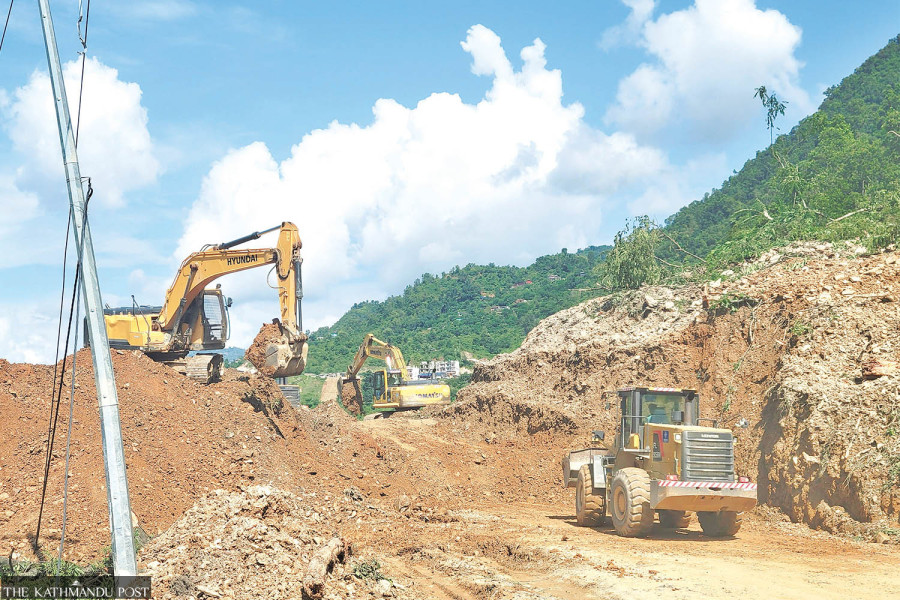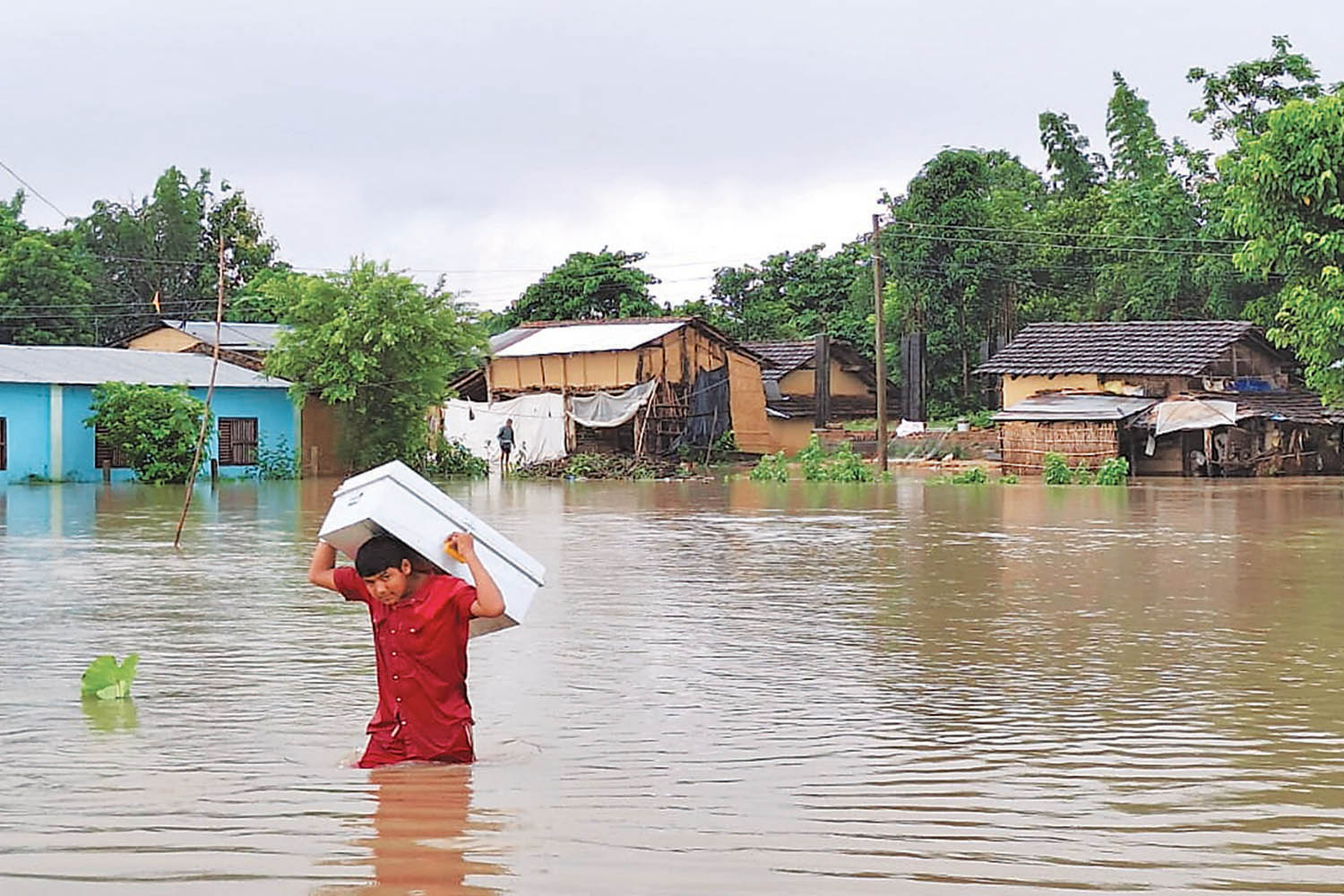National
Floods displace 800 families in Kailali as rains wreak havoc in several districts
A massive landslide blocked Prithvi Highway in Tanahun for 24 hours leaving hundreds of passengers stranded.
Arjun Shah & Samjhana Rasaili
Heavy monsoon rains disrupted life in several districts over the past two days. Landslides blocked some of the major highways while several settlements, mainly in the southern plain, have been flooded.
More than 800 families have been displaced as floods triggered by heavy rains inundated several settlements in Kailali, a western Tarai district in Sudurpaschim Province. Bhajani Municipality is hardest hit by the inundation. As per the preliminary report of the municipality, around 750 families have been displaced while 4,127 families have been affected.
The displaced people have been staying on the Postal Highway, which is higher than the ground level, by pitching tents while some others are taking shelter in schools and other community buildings.
Several settlements in all nine wards of Bhajani were waterlogged as the rain-swollen Kandra, Kanda, Pathariya, Kataini and Mohana rivers breached their banks and entered the settlements. Around 75 percent of land in Bhajani has been under water since Wednesday night.
Similarly, Kailari Rural Municipality, Ghodaghodi and Gauriganga municipalities have been also affected due to the floods and inundation. “My house collapsed after being submerged, and the floodwaters damaged our food grains. We have nothing to eat,” lamented Mahanu Chaudhary of Khonpur in ward 3 of Kailari. Chaudhary’s family is currently staying with relatives.
Security personnel rescued 16 people who were trapped in the floods in Kailari and Gauriganga. According to Chief District Officer Dharmendra Kumar Mishra, 12 people were rescued in Kailari while security personnel rescued four people in Gauriganga. The flooded Kataini river swept away Ramkrishna Chaudhari and his wife Lokmaya in Bayaspur, ward 5 of Kailari, on Wednesday evening. The Armed Police Force personnel rescued the Chaudhary couple from a tree some 500 metres downstream from the incident site.
Similarly, a massive landslide blocked the Damauli-Dumre section of the Prithvi Highway at Ghansikuwa in ward 1 of Byas Municipality in Tanahun district, for 24 hours. Hundreds of passengers were stranded on the highway that connects the country’s two major cities—Kathmandu and Pokhara—for hours.
The mudslide erupted from approximately 50 metres above the highway at around 5pm on Wednesday. “Following the relentless efforts, single-lane traffic resumed along the road section from 5:40pm on Thursday,” said Deputy Superintendent of Police Deepak Kumar Raya.
The security personnel and employees of the road division office started clearing the debris early in the morning, but the sheer scale of the landslide caused significant delays in reopening the road.
Earlier, the authorities urged motorists to use alternative routes. Small and medium vehicles have been advised to take a detour through Damauli to Talghare and rejoin the highway via Ranigaun, or alternatively, take the Ranigaun-Ghansikuwa route towards Dumre, Tanahun.
Likewise, a landslide disrupted transportation along the Dumre-Besisahar road section on Thursday. The landslide at Ramailodanda in ward 1 of Bhanu Municipality blocked the road section at around 1pm. The traffic was diverted through Bhansar-Nareshworta-Armed Police Force Battalion road section.
Similarly, the Dang-Salyan-Surkhet and the Kapurkot-Phalawang roads under the Madan Bhandari Highway have been blocked since Thursday morning due to landslides triggered by continuous rainfall.
According to the District Police Office, Salyan, a landslide at Tateli in ward 4 of Kalimati Rural Municipality has blocked the Dang-Salyan-Surkhet road, while the Kapurkot-Phalawang road has been obstructed at Kimuchaur after the road was swept away by the landslide.
A team of security personnel has been deployed to the site to clear the debris and restore traffic movement, said Police Inspector Resham Bahadur Khatri, the information officer at the District Police Office, Salyan.
Efforts are ongoing to reopen the blocked roads, but continuous rainfall and difficult terrain are hampering the progress. Authorities have urged travellers to avoid the affected routes until the situation is resolved.
In Darchula, residents of Kotila settlement in ward 4 of Mallikarjun Rural Municipality are hugely affected after a landslide damaged a drinking water project on Monday. According to Pawan Singh Dhami, a local resident, the landslide damaged the Kotila Lifting Drinking Water Project. “The settlement is experiencing a severe shortage of drinking water. The villagers have to walk for hours to find drinking water,” said Dhami.
It started raining heavily in various parts of the country on Tuesday night. The Meteorological Forecasting Division says that the monsoon trough's axis, which shifted north of its normal position (close to Nepal), has been driving continuous rainfall across the country since Tuesday night. Additionally, a low-pressure area or cyclonic circulation that has formed near Pokhara further contributed to the continuous rainfall.

Around 200 people have died and dozens have been injured in rain-related incidents—landslides, floods, lightning strikes, and others since the start of the monsoon on June 10 this year.
The monsoon season in Nepal generally begins on June 13 and ends on September 23. This year southwest monsoon entered Nepal on June 10, three days ahead of the usual onset date. Last year, it started on June 14, a day later than the normal onset date.
A normal monsoon, supported by the timely arrival of rain, translates into favourable agricultural production, mainly of paddy, and is further linked with the country’s overall economic growth.
The monsoon season, which delivers around 80 percent of the country’s annual rainfall, generally lasts 105 days. However, in recent years, its withdrawal has taken more time.
The Met Office has forecast above-normal rains and above-average maximum and minimum temperatures this monsoon, which could unleash extreme weather events, such as flooding, inundation, and landslides.
The department’s climate section has issued a weather forecast for four months, from June to September. It said most parts of the country will likely experience above-average minimum and maximum temperatures and rainfall due to weakened El Nino conditions and the development of La Nina conditions.
El Nino refers to climatic patterns in which ocean surface temperatures warm unusually. La Nina is the opposite, in which the ocean surface cools off.
Data from the Department of Hydrology and Meteorology show that the country has already received around 80 percent of the average rainfall for the entire monsoon season this year.
Nepal is one of the world’s most vulnerable countries to the climate crisis and has witnessed multiple extreme weather events over the past decade and a half.
Evidence suggests that maximum temperatures in Nepal are rising faster, at 0.056 degrees Celsius a year, compared to the global average rise of 0.03 degrees Celsius yearly.
Experts say extreme weather events—excessive rainfall in a short period, continuous rains for several days after the monsoon, dry spells, droughts, below-average precipitation, and above-normal winter temperatures—have become more frequent in Nepal.
The National Disaster Risk Reduction and Management Authority estimates that the monsoon will affect 1.81 million people and 412,000 households this year. Of them, 83,000 households will be directly impacted, and 18,000 families will require rescue due to monsoon-related disasters.
(With inputs from our local correspondents)




 22.64°C Kathmandu
22.64°C Kathmandu













